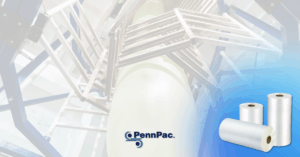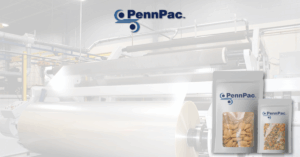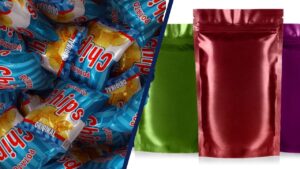
Flexible packaging films are all around us—preserving the freshness of snacks, sealing in the flavor of coffee, and protecting critical products in personal care, medical, and industrial markets. Have you ever wondered how those ultra-thin, high-performance films actually come to life?
At PennPac, we work with converters and end-users across North America who rely on high-quality, precision-slit flexible films. Understanding how these materials are made helps our customers appreciate the science behind the roll and make smarter sourcing decisions. Let’s take a look at how flexible packaging film is produced—starting at the very beginning: resin pellets.
Step 1: Resin Selection
The process begins with tiny plastic pellets known as resin, which are typically made from polymers such as:
- Polypropylene (PP) – used in BOPP films for snack and bakery packaging
- Polyethylene (PE) – common in sealant layers and stretch films
- Polyester (PET) – used for durability and high-barrier applications
These resins may be virgin, recycled, or bio-based, depending on the sustainability goals of the brand.
Step 2: Extrusion
In the extrusion process, resin pellets are melted down and formed into a thin film. There are a few main types of extrusion:
- Cast Film Extrusion – resin is melted and cast onto a chilled roller, creating smooth, consistent film.
- Blown Film Extrusion – the resin is extruded into a bubble, then cooled and flattened into film.
- Biaxial Orientation (BOPP, BOPET) – film is stretched in two directions to improve strength, clarity, and barrier properties.
This is the foundational step where the base structure of the film is created.
Step 3: Coating & Laminating
Depending on end-use needs, films may undergo additional processing:
Lamination bonds two or more films together, such as PET and PE, to combine properties like strength and sealability.
Coating adds functionality, such as anti-fog, print adhesion, or oxygen barriers.
These enhancements are key for food safety, product visibility, and shelf appeal.
Step 4: Slitting
Large “master rolls” of film are far too wide for end-user packaging machines or typical flexographic presses. That’s where secondary or toll slitting comes in.
At PennPac, we specialize in toll slitting—precisely converting jumbo rolls into narrower widths or custom formats based on the converter’s specifications. Clean, accurate slitting helps:
- Minimize waste
- Improve machine performance
- Reduce downtime
This step ensures that packaging lines run efficiently and film properties are preserved from start to finish.
Read more about how PennPac can handle all of your slitting needs. Click Here!
Step 5: Delivery & Application
Once slit, the film is packaged and shipped to converters or brand owners, where it’s turned into:
- Bags and pouches
- Wraps and lidding film
- Labels and overwraps
Converters then add graphics, die-cutting, and seals to create the final product consumers see on the shelf.
The End Result
From resin to roll, every step of the film manufacturing process plays a vital role in delivering quality, consistency, and performance. Whether it’s protecting food, extending shelf life, or supporting sustainability goals, flexible packaging films are precision-engineered materials that deserve attention and understanding.
At PennPac, we support that journey by delivering slitting and distribution services that ensure your material arrives ready to perform. We don’t just move film — we add value at every turn.



